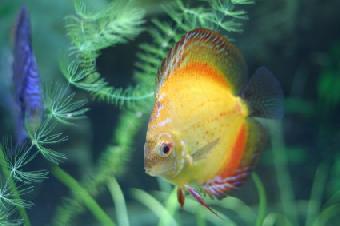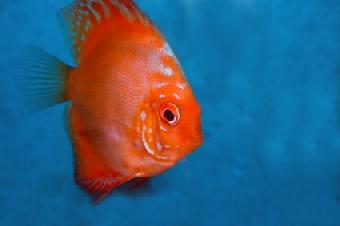Discus

Discus (Symphysodon spp.) are exotic looking freshwater fish. They are from the family Cichlidae most commonly called the cichlids. The cichlids are a family of fish that include several genera and species, including freshwater angelfish and the African cichlids, as well as others. Discus are originally from the Amazon River in South America.
Discus are more fragile and sensitive to water conditions that most freshwater fish. Because the water in the Amazon River is soft and slightly acidic, this is what they are most adapted to, and what should be maintained in their aquarium. Discus are not for beginning aquarists.

The pH should be about 6.0-6.5 and and the water should be soft. To soften the water and lower the pH you can filter the water through peat or you can add a thin layer of peat under the substrate. If you add peat to your aquarium be sure that it contains no additives or fertilizers that may harm your fish. The water temperature should be between 77-86 degrees Fahrenheit or 25-30 degrees Celsius. You'll need a large tank to house your discus in. They grow to about 5.5-6.5 inches and it is best to keep around 6-8 of them together.
The genus Symphysodon has two species: S. aequiafasciata and S. discus.
S. aequiafasciata is divided into three subspecies:
- S. aequiafasciata aequiafasciata - green discus
- S. aequiafasciata axelrodi - brown discus
- S. aequiafasciata haraldi - blue discus
There are two subspecies of Symphysodon discus:
- S. discus discus - red discus
- S. discus willischwartzi - pineapple discus

It has been argued by some that all of these subspecies are just variations of the same species. Also, through selective breeding there are now many different types and colors of discus available. Many of the discus available are hybrids. Discus are some of the most colorful freshwater fish in existance.
Discus are rather expensive freshwater fish. The prices generally range from about 50 to 170 dollars or more. Discus usually live 10 years or more in the correct water conditions and barring any serious disease.
Diet
Discus are mostly carnivores. Most pet stores sell food specifically made for discus. They will also eat freeze-dried foods (tubifex and bloodworms), frozen meaty foods, and flakes.

Discus Breeding and Care of Their Fry
Male and female discus look very similar to one another, and so sexing them is rather difficult. There is no reliable way that I know of to determine their sex. As mentioned earlier in this article, you should have several discus in your tank. The males and females should pair off and then you can place the pairs in their own breeding tank. It is unlikely if you have 6-8 discus in your tank that you will end up with all males or all females (but I guess it's not impossible).
Discus lay their eggs on a leaf or other surface that they have cleaned prior to spawning. The eggs hatch in about 48 hours. Before the eggs hatch the parents guard them, fanning them and cleaning them. Once the fry hatch they won't be free-swimming for about 3 days. Once they are free-swimming they eat a mucous secretion off the skin of their parents. Because of this, you must leave the parents with their fry for at least a few days and a week or two may be even better. After a few days you can also supplement the frys' diet with newly hatched brine shrimp.
